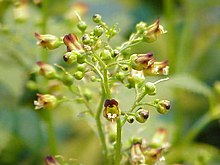Scrophularia nodosa
| Scrophularia nodosa | |
|---|---|

| |
| Scientific classification | |
| Kingdom: | Plantae |
| Clade: | Tracheophytes |
| Clade: | Angiosperms |
| Clade: | Eudicots |
| Clade: | Asterids |
| Order: | Lamiales |
| Family: | Scrophulariaceae |
| Genus: | Scrophularia |
| Species: | S. nodosa
|
| Binomial name | |
| Scrophularia nodosa | |
Scrophularia nodosa (also called figwort, woodland figwort, and common figwort) is a perennial herbaceous plant found in temperate regions of the Northern hemisphere except western North America.[1] It grows in moist and cultivated waste ground.[2]
Growth
It grows upright, with thick, sharply square, succulent stems up to 150 cm tall from a horizontal rootstock. Its leaves are opposite, ovate at the base and lanceolate at the tip, all having toothed margins. The flowers are in loose cymes in oblong or pyramidal panicles. The individual flowers are globular, with five green sepals encircling green or purple petals, giving way to an egg-shaped seed capsule.[3]

Fossil record
Seed identification of Scrophularia nodosa has been made from sub-stage IIIa of the Hoxnian at Clacton in Essex, from the Middle Pleistocene.[4]
Folklore
The plant was thought, by the doctrine of signatures, to be able to cure the throat disease scrofula because of the throat-like shape of its flowers.[5]
References
- ^ Mills, S., The Complete Guide to Modern Herbalism, Thorsons, Great Britain, 1994.
- ^ PLANTS Profile for Scrophularia nodosa (woodland figwort) | USDA PLANTS
- ^ "Figwort". Archived from the original on 2015-09-23. Retrieved 2007-05-03.
- ^ The History of the British Flora, A Factual Basis for Phytogeography by Sir Harry Godwin, Cambridge University Press, Cambridge, ISBN 0 521 20254 X, 1975 edition page 318
- ^ "Figwort". Archived from the original on 2011-06-05. Retrieved 2017-09-11.
External links
- Articles with short description
- Short description is different from Wikidata
- Articles with 'species' microformats
- Commons link is on Wikidata
- Taxonbars with 25–29 taxon IDs
- Articles with NKC identifiers
- Scrophularia
- Medicinal plants
- Flora of Northern America
- Plants described in 1753
- Taxa named by Carl Linnaeus